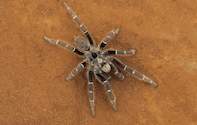
They're big and hairy and in need of conservation and are found in the Kruger National Park (KNP) - but they have double the normal number of legs. They are baboon spiders. Kruger is home to no less than seven different species of baboon spider, including a species that was only recently discovered by scientists and given its official name of Ceratogyrus paulseni last year.
The new species of baboon spider was discovered in a clearing in the mopane-acacia woodland near Letaba and has not yet been found anywhere else in Kruger, or the rest of the world. Despite the fact that the Kruger's known species of baboon spider come from four different genera, they are hard for a layman to tell apart.

The newly discovered species does, however, have the one characteristic that allows it to be told apart from the other genera - it has a distinctive 'horn' on its back, which it shares with the more common horned baboon spider. The new baboon spider was first spotted during a 2003 spider survey of Kruger that forms part of the ongoing South African National Survey of Arachnids.
Arachnids are eight-legged animals that have jointed legs, and include spiders, scorpions, solifuges, ticks and mites amongst others. As a group spiders are predatory animals and are generally very successful, with more than 36,000 known species worldwide and many more unknown, but they have been little studied and mostly ignored in conservation efforts.
In order for conservation efforts to be successful, environmentalists need to know what that are dealing with, which has lead to the surveys of spiders in Kruger and the rest of the country. One of South Africa's leading authorities on spiders is Dr Ansie Dippenaar-Schoeman from the Agricultural Research Council, Plant Protection Research Institute (ARC-PPRI).
She is heading up the survey of Kruger's spiders, which mainly involves researchers conducting spider-collecting trips. On each trip, the researchers continue to find species that were not previously known to occur in the park, as well as species new to science although not all as spectacular to the layman as the new baboon spider.

At this point, there are over 220 known species of arachnids (not counting the ticks and mites) found in Kruger.
The bulk of these are true spiders, with nine species of scorpions, seven pseudo-scorpions and 18 different kinds of solifuges (sun spiders, roman spiders), two types of 'daddylong legs' harvestmen and a tailless whip scorpion species(Left).
Prickly Pears And Spiders
Along with spider collecting trips, other spider research is currently ongoing in Kruger. Researcher Kyle Harris is looking at spiders in conjunction with one of Kruger's most pressing problems - the invasion of the park by alien species. Prickly pears (Opuntia stricta) are one of the park's biggest headaches in terms of invasive plants, with about 30,000 ha of land near Skukuza currently being invaded by the plant.
Two biological control agents have been released to try and quell the invasion in the park, but given the fact that seeds are capable of lying dormant for 15 years before germinating the prickly pear invasion is likely to plague Kruger for some time.
To try and monitor what effects the aliens are having on biodiversity, Kyle is looking at how many different kinds of spiders and beetles are found in pristine areas of the park compared to those that are not invaded, moderately invaded or heavily invaded by the prickly pear. Over the course of a year, he has collected beetles and spiders every two months in the different infestation types.
Kyle finds his subjects by digging two litre buckets into the ground and collecting all creepy crawlies that walk into these pitfall traps. He also collects the leaf litter lying on the ground in the different study areas and sieves it through a 5x5mm mesh screen, collecting all the bugs that fall through the mesh.
Kyle also spends 15 minutes in each patch actively looking under rocks, on the ground and under logs and tree bark for beetles and spiders, which he then collects for identification. Although not all the spiders have been identified yet, 80 beetle species have been found. His project is expected to be completed by next July, when he will be able to tell Kruger which species of beetles and spiders survive at the different levels of prickly pear invasion.
The research will also point the way towards identifying which species can be used by park managers to detect whether a plant invasion is worsening or improving as a result of control measures. This will help guide management decisions as to whether or not alien plant eradication measures must be increased.
All the spiders collected by Kyle will be added to the inventory of Kruger's spiders that Ansie Dippenaar-Schoeman is compiling, and she reports that new records for the park are flooding in as she assesses his specimens.
However, one of Ansie's future priorities for spider research in the park is a survey of the larger baboon and trapdoor spiders and scorpions that occur in the park. This will be able to pinpoint which species are the most widespread in the park and which species are most in need of conservation.
Melissa Wray

 African Wildlife Research - The enquiring mind of humanity is our most important asset in the struggle for physical survival on earth. The ...
African Wildlife Research - The enquiring mind of humanity is our most important asset in the struggle for physical survival on earth. The ...